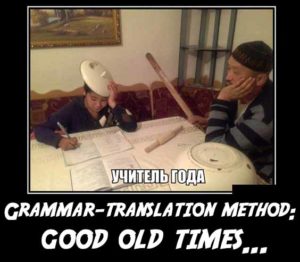Russian Learning Methods: Ebb And Flow
The Iron Curtain – A Thorn In The Way Of Language Learning
 Most students start their Russian journey “with the wrong foot” because their teachers choose low-efficient methods. I must say it is not the teachers’ fault that they do that. They have been taught to use the least optimal methodology. You might be asking now, how on Earth could that happen? The answer is two short words – the “Iron Curtain”.
Most students start their Russian journey “with the wrong foot” because their teachers choose low-efficient methods. I must say it is not the teachers’ fault that they do that. They have been taught to use the least optimal methodology. You might be asking now, how on Earth could that happen? The answer is two short words – the “Iron Curtain”.
 It all started in the USSR where school education was strongly founded on a science-based approach which implied getting to the core of the subject, analyzing and reveling its inner structure, explaining the various connections between its elements. Linguistic education was no exception. When learning a foreign language (English, German or French), school students were trained to see and recognize various grammatical patterns and later use the knowledge of these grammatical patterns when reading texts, mostly fiction or publicistic style.
It all started in the USSR where school education was strongly founded on a science-based approach which implied getting to the core of the subject, analyzing and reveling its inner structure, explaining the various connections between its elements. Linguistic education was no exception. When learning a foreign language (English, German or French), school students were trained to see and recognize various grammatical patterns and later use the knowledge of these grammatical patterns when reading texts, mostly fiction or publicistic style.
 A teacher used to present a grammatical pattern or rule, then he used to give the students a number of exercises to reinforce their knowledge of this rule, and after that they were reading a text and translating it. This was called a grammar-translation method.
A teacher used to present a grammatical pattern or rule, then he used to give the students a number of exercises to reinforce their knowledge of this rule, and after that they were reading a text and translating it. This was called a grammar-translation method.
 I would like to remind you that all of this was happening while the “Iron Curtain” was hanging over the country dividing Russia from Western countries and Western countries from Russia, so Russian students had little opportunity to practice the grammar material they learned in class.
I would like to remind you that all of this was happening while the “Iron Curtain” was hanging over the country dividing Russia from Western countries and Western countries from Russia, so Russian students had little opportunity to practice the grammar material they learned in class.
 All the text books were written by Soviet authors, all the tapes were recorded by non-native speakers, and it was problematic to find an authentic recording. In addition to that, even songs in English (or any other foreign language) were hard to find.
All the text books were written by Soviet authors, all the tapes were recorded by non-native speakers, and it was problematic to find an authentic recording. In addition to that, even songs in English (or any other foreign language) were hard to find.
You don’t have to be a PhD in linguistics to understand that without enough practice the biggest part of what students learned just stayed in their passive memory and never came to the level of spontaneous active usage.
 Soviet students who were lucky enough to go abroad on an exchange program or for any other reason did not understand much of the language they were studying in school.
Soviet students who were lucky enough to go abroad on an exchange program or for any other reason did not understand much of the language they were studying in school.
However, they had a good foundation. All the grammar rules and patterns they learned made a solid theoretical basis that could have been turned into a high level of proficiency had there been more practice.
Please mind that the state of affairs described above was applicable to both teaching foreign languages in Russian schools and teaching Russian as a foreign language at universities where there were quite a few foreign students (mainly from the “Soviet block” countries in Africa, Asia and Eastern Europe).
“Communicative” Approach: Behind The Mask
 Upon the fall of the “Iron Curtain” the approaches in teaching foreign languages divided into two main tendencies: one followed in the footsteps of the Soviet tradition and the other advocated a so-called “communicative approach”. The “communicative approach” or “communicative method” implied minimum grammar studying and concentrating on conversational topics, such as “My family”, “My hobbies and interests”, “My hometown/My country” and so on.
Upon the fall of the “Iron Curtain” the approaches in teaching foreign languages divided into two main tendencies: one followed in the footsteps of the Soviet tradition and the other advocated a so-called “communicative approach”. The “communicative approach” or “communicative method” implied minimum grammar studying and concentrating on conversational topics, such as “My family”, “My hobbies and interests”, “My hometown/My country” and so on.
 The traditional approach held up well in state-owned educational institutions until mid-2000s when they gave in and started using liberalistic “communicative” text books. I always put “communicative” in quotation marks because this approach didn’t actually help students communicate in the target language. Without a solid grammar foundation they were left “floating in the air” snatching at a few phrases that they learned from conversational topics and having a limited ability to go beyond these phrases.
The traditional approach held up well in state-owned educational institutions until mid-2000s when they gave in and started using liberalistic “communicative” text books. I always put “communicative” in quotation marks because this approach didn’t actually help students communicate in the target language. Without a solid grammar foundation they were left “floating in the air” snatching at a few phrases that they learned from conversational topics and having a limited ability to go beyond these phrases.
 However, liberalist educators and teachers’ supervisors stood their ground because they hated everything that came from the Soviet Union. This “virus of liberalism” attacked many cells in the body of Russian system of education and afflicted the National Standard in Russian Language Proficiency for Foreigners.
However, liberalist educators and teachers’ supervisors stood their ground because they hated everything that came from the Soviet Union. This “virus of liberalism” attacked many cells in the body of Russian system of education and afflicted the National Standard in Russian Language Proficiency for Foreigners.
New Path Breakers
 Teachers who taught Russian as a foreign language in state-owned institutions had to comply with new standards and use the text books that were written by liberalist authors. However, there were enthusiastic teachers in private schools who were still devoted to the fundamental Soviet approach and its focus on grammar but who also knew about its downsides in terms of lack of practice and who tried to correct these downsides now when the Iron Curtain fell.
Teachers who taught Russian as a foreign language in state-owned institutions had to comply with new standards and use the text books that were written by liberalist authors. However, there were enthusiastic teachers in private schools who were still devoted to the fundamental Soviet approach and its focus on grammar but who also knew about its downsides in terms of lack of practice and who tried to correct these downsides now when the Iron Curtain fell.  These enthusiasts took the best from the Soviet educational tradition and combined it with their practical experience of learning English and other foreign languages. They didn’t focus on conversational topics, since this strategy led to random, unsystematic knowledge, but they created methods that were centered on the most optimal sequence of grammar topics reinforced with an optimal choice of vocabulary and a system of specially designed practical exercises and authentic dialogues.
These enthusiasts took the best from the Soviet educational tradition and combined it with their practical experience of learning English and other foreign languages. They didn’t focus on conversational topics, since this strategy led to random, unsystematic knowledge, but they created methods that were centered on the most optimal sequence of grammar topics reinforced with an optimal choice of vocabulary and a system of specially designed practical exercises and authentic dialogues.
Among these new forward-looking teaching methods there was one that led students to quickest results, and here at ARusPro we currently continue to use, develop and enrich this method tailoring it to the needs of our students. All our tutors show absolute mastery of this method. All candidates to a tutor position are first tested at the interview and then go through a training course for the method we use with a compulsory exam at the end of the course. Based on the results of the exam I make a decision whether to hire this person or not. Tutors who pass the exam successfully can be later seen on our “Tutors” page.
ARusPro Team On The Cutting Edge Of The
“Russian Thinker”
Method
 We can also say with confidence that we fully adapted this method to Skype lessons. Our tutors use high-end software to make the presentation of the material as clear, fast and efficient as possible. Various screen-management programs allow us to be quick with arranging windows and opening study materials. We have everything at hand on our computers thanks to the file management systems and quick through-computer search that we use.
We can also say with confidence that we fully adapted this method to Skype lessons. Our tutors use high-end software to make the presentation of the material as clear, fast and efficient as possible. Various screen-management programs allow us to be quick with arranging windows and opening study materials. We have everything at hand on our computers thanks to the file management systems and quick through-computer search that we use.
 You won’t have to spend precious minutes of the lesson waiting for your tutor to find a certain file. Of course, our tutors prepare all the materials in advance. However, during lessons we often come across situations when we need to quickly pull out a diagram, picture, or a chart to answer the student’s question. In such cases the above mentioned technology really comes to rescue.
You won’t have to spend precious minutes of the lesson waiting for your tutor to find a certain file. Of course, our tutors prepare all the materials in advance. However, during lessons we often come across situations when we need to quickly pull out a diagram, picture, or a chart to answer the student’s question. In such cases the above mentioned technology really comes to rescue.
We also use high-quality equipment and the fastest Internet connection to make sure our lessons go smooth as if the student and the tutor were in the same room.
 We constantly learn ourselves enriching the method with the latest achievements in psychology and education science. We are a small business, so I personally make sure each tutor regularly upgrades her skills in teaching, uses the latest technology and also broadens her outlook. Our tutors are well-informed on a wide range of topics from politics to sports, so they are able to create study materials based on your specific interests. You will always be able to talk to our tutors about things you like, and that (talking about things you like or things that move your soul in some way) will encourage you to continue learning this language and help you stay motivated until you achieve Russian proficiency.
We constantly learn ourselves enriching the method with the latest achievements in psychology and education science. We are a small business, so I personally make sure each tutor regularly upgrades her skills in teaching, uses the latest technology and also broadens her outlook. Our tutors are well-informed on a wide range of topics from politics to sports, so they are able to create study materials based on your specific interests. You will always be able to talk to our tutors about things you like, and that (talking about things you like or things that move your soul in some way) will encourage you to continue learning this language and help you stay motivated until you achieve Russian proficiency.
A few words on the method that we chose as fundamental for our teaching.
We call this method a “Russian thinker” method because it helps students start thinking in Russian.
Why does the “Russian thinker” method work?
 1) It uses the correct sequence of grammar topics that helps your brain build a system of consistent neural connections and thus helps you remember better and start thinking in Russian very soon.
1) It uses the correct sequence of grammar topics that helps your brain build a system of consistent neural connections and thus helps you remember better and start thinking in Russian very soon.
2) It is based on authentic language material. We start using authentic dialogues from the very first lessons. No more weird texts and dialogues. Only live spoken Russian language.
3) We explain every little detail in a Russian sentence (from word order to little words like “же”, “так”, “ведь” that “mean everything and nothing”). Our tutors and language experts have been working on describing the contexts of using the words that present difficulties for learners, and we have been successful in it. If you learn to use these little words correctly, they will not only help you sound like a native, but also boost your “Russian thinking” ability.

4) Context description together with the right sequence of grammar material make the two pillars on which this method rests. In order to be able to speak Russian like a native, you should be able to see the whole situation (the context in which your conversation is going on) the way Russians see it. Russian and English speakers normally look at one and the same situation from different angles, therefore they describe the situation with different language means.
Native speakers cannot always show you the context behind a certain phrase or construction, but our tutors have been analyzing these contexts for years, so they can easily take you through it.
Russian Learning Methods: Ebb And Flow
The Iron Curtain – A Thorn In The Way Of Language Learning
 Most students start their Russian journey “with the wrong foot” because their teachers choose low-efficient methods. I must say it is not the teachers’ fault that they do that. They have been taught to use the least optimal methodology. You might be asking now, how on Earth could that happen? The answer is two short words – the “Iron Curtain”.
Most students start their Russian journey “with the wrong foot” because their teachers choose low-efficient methods. I must say it is not the teachers’ fault that they do that. They have been taught to use the least optimal methodology. You might be asking now, how on Earth could that happen? The answer is two short words – the “Iron Curtain”.
 It all started in the USSR where school education was strongly founded on a science-based approach which implied getting to the core of the subject, analyzing and reveling its inner structure, explaining the various connections between its elements. Linguistic education was no exception. When learning a foreign language (English, German or French), school students were trained to see and recognize various grammatical patterns and later use the knowledge of these grammatical patterns when reading texts, mostly fiction or publicistic style.
It all started in the USSR where school education was strongly founded on a science-based approach which implied getting to the core of the subject, analyzing and reveling its inner structure, explaining the various connections between its elements. Linguistic education was no exception. When learning a foreign language (English, German or French), school students were trained to see and recognize various grammatical patterns and later use the knowledge of these grammatical patterns when reading texts, mostly fiction or publicistic style.
 A teacher used to present a grammatical pattern or rule, then he used to give the students a number of exercises to reinforce their knowledge of this rule, and after that they were reading a text and translating it. This was called a grammar-translation method.
A teacher used to present a grammatical pattern or rule, then he used to give the students a number of exercises to reinforce their knowledge of this rule, and after that they were reading a text and translating it. This was called a grammar-translation method.
 I would like to remind you that all of this was happening while the “Iron Curtain” was hanging over the country dividing Russia from Western countries and Western countries from Russia, so Russian students had little opportunity to practice the grammar material they learned in class.
I would like to remind you that all of this was happening while the “Iron Curtain” was hanging over the country dividing Russia from Western countries and Western countries from Russia, so Russian students had little opportunity to practice the grammar material they learned in class.
 All the text books were written by Soviet authors, all the tapes were recorded by non-native speakers, and it was problematic to find an authentic recording. In addition to that, even songs in English (or any other foreign language) were hard to find.
All the text books were written by Soviet authors, all the tapes were recorded by non-native speakers, and it was problematic to find an authentic recording. In addition to that, even songs in English (or any other foreign language) were hard to find.
You don’t have to be a PhD in linguistics to understand that without enough practice the biggest part of what students learned just stayed in their passive memory and never came to the level of spontaneous active usage.
 Soviet students who were lucky enough to go abroad on an exchange program or for any other reason did not understand much of the language they were studying in school.
Soviet students who were lucky enough to go abroad on an exchange program or for any other reason did not understand much of the language they were studying in school.
However, they had a good foundation. All the grammar rules and patterns they learned made a solid theoretical basis that could have been turned into a high level of proficiency had there been more practice.
Please mind that the state of affairs described above was applicable to both teaching foreign languages in Russian schools and teaching Russian as a foreign language at universities where there were quite a few foreign students (mainly from the “Soviet block” countries in Africa, Asia and Eastern Europe).
“Communicative” Approach: Behind The Mask
 Upon the fall of the “Iron Curtain” the approaches in teaching foreign languages divided into two main tendencies: one followed in the footsteps of the Soviet tradition and the other advocated a so-called “communicative approach”. The “communicative approach” or “communicative method” implied minimum grammar studying and concentrating on conversational topics, such as “My family”, “My hobbies and interests”, “My hometown/My country” and so on.
Upon the fall of the “Iron Curtain” the approaches in teaching foreign languages divided into two main tendencies: one followed in the footsteps of the Soviet tradition and the other advocated a so-called “communicative approach”. The “communicative approach” or “communicative method” implied minimum grammar studying and concentrating on conversational topics, such as “My family”, “My hobbies and interests”, “My hometown/My country” and so on.
 The traditional approach held up well in state-owned educational institutions until mid-2000s when they gave in and started using liberalistic “communicative” text books. I always put “communicative” in quotation marks because this approach didn’t actually help students communicate in the target language. Without a solid grammar foundation they were left “floating in the air” snatching at a few phrases that they learned from conversational topics and having a limited ability to go beyond these phrases.
The traditional approach held up well in state-owned educational institutions until mid-2000s when they gave in and started using liberalistic “communicative” text books. I always put “communicative” in quotation marks because this approach didn’t actually help students communicate in the target language. Without a solid grammar foundation they were left “floating in the air” snatching at a few phrases that they learned from conversational topics and having a limited ability to go beyond these phrases.
 However, liberalist educators and teachers’ supervisors stood their ground because they hated everything that came from the Soviet Union. This “virus of liberalism” attacked many cells in the body of Russian system of education and afflicted the National Standard in Russian Language Proficiency for Foreigners.
However, liberalist educators and teachers’ supervisors stood their ground because they hated everything that came from the Soviet Union. This “virus of liberalism” attacked many cells in the body of Russian system of education and afflicted the National Standard in Russian Language Proficiency for Foreigners.
New Path Breakers
 Teachers who taught Russian as a foreign language in state-owned institutions had to comply with new standards and use the text books that were written by liberalist authors. However, there were enthusiastic teachers in private schools who were still devoted to the fundamental Soviet approach and its focus on grammar but who also knew about its downsides in terms of lack of practice and who tried to correct these downsides now when the Iron Curtain fell.
Teachers who taught Russian as a foreign language in state-owned institutions had to comply with new standards and use the text books that were written by liberalist authors. However, there were enthusiastic teachers in private schools who were still devoted to the fundamental Soviet approach and its focus on grammar but who also knew about its downsides in terms of lack of practice and who tried to correct these downsides now when the Iron Curtain fell.  These enthusiasts took the best from the Soviet educational tradition and combined it with their practical experience of learning English and other foreign languages. They didn’t focus on conversational topics, since this strategy led to random, unsystematic knowledge, but they created methods that were centered on the most optimal sequence of grammar topics reinforced with an optimal choice of vocabulary and a system of specially designed practical exercises and authentic dialogues.
These enthusiasts took the best from the Soviet educational tradition and combined it with their practical experience of learning English and other foreign languages. They didn’t focus on conversational topics, since this strategy led to random, unsystematic knowledge, but they created methods that were centered on the most optimal sequence of grammar topics reinforced with an optimal choice of vocabulary and a system of specially designed practical exercises and authentic dialogues.
Among these new forward-looking teaching methods there was one that led students to quickest results, and here at ARusPro we currently continue to use, develop and enrich this method tailoring it to the needs of our students. All our tutors show absolute mastery of this method. All candidates to a tutor position are first tested at the interview and then go through a training course for the method we use with a compulsory exam at the end of the course. Based on the results of the exam I make a decision whether to hire this person or not. Tutors who pass the exam successfully can be later seen on our “Tutors” page.
ARusPro Team On The Cutting Edge Of The “Russian Thinker” Method
 We can also say with confidence that we fully adapted this method to Skype lessons. Our tutors use high-end software to make the presentation of the material as clear, fast and efficient as possible. Various screen-management programs allow us to be quick with arranging windows and opening study materials. We have everything at hand on our computers thanks to the file management systems and quick through-computer search that we use.
We can also say with confidence that we fully adapted this method to Skype lessons. Our tutors use high-end software to make the presentation of the material as clear, fast and efficient as possible. Various screen-management programs allow us to be quick with arranging windows and opening study materials. We have everything at hand on our computers thanks to the file management systems and quick through-computer search that we use.
 You won’t have to spend precious minutes of the lesson waiting for your tutor to find a certain file. Of course, our tutors prepare all the materials in advance. However, during lessons we often come across situations when we need to quickly pull out a diagram, picture, or a chart to answer the student’s question. In such cases the above mentioned technology really comes to rescue.
You won’t have to spend precious minutes of the lesson waiting for your tutor to find a certain file. Of course, our tutors prepare all the materials in advance. However, during lessons we often come across situations when we need to quickly pull out a diagram, picture, or a chart to answer the student’s question. In such cases the above mentioned technology really comes to rescue.
We also use high-quality equipment and the fastest Internet connection to make sure our lessons go smooth as if the student and the tutor were in the same room.
 We constantly learn ourselves enriching the method with the latest achievements in psychology and education science. We are a small business, so I personally make sure each tutor regularly upgrades her skills in teaching, uses the latest technology and also broadens her outlook. Our tutors are well-informed on a wide range of topics from politics to sports, so they are able to create study materials based on your specific interests. You will always be able to talk to our tutors about things you like, and that (talking about things you like or things that move your soul in some way) will encourage you to continue learning this language and help you stay motivated until you achieve Russian proficiency.
We constantly learn ourselves enriching the method with the latest achievements in psychology and education science. We are a small business, so I personally make sure each tutor regularly upgrades her skills in teaching, uses the latest technology and also broadens her outlook. Our tutors are well-informed on a wide range of topics from politics to sports, so they are able to create study materials based on your specific interests. You will always be able to talk to our tutors about things you like, and that (talking about things you like or things that move your soul in some way) will encourage you to continue learning this language and help you stay motivated until you achieve Russian proficiency.
A few words on the method that we chose as fundamental for our teaching.
We call this method a “Russian thinker” method because it helps students start thinking in Russian.
Why does the “Russian thinker” method work?
 1) It uses the correct sequence of grammar topics that helps your brain build a system of consistent neural connections and thus helps you remember better and start thinking in Russian very soon.
1) It uses the correct sequence of grammar topics that helps your brain build a system of consistent neural connections and thus helps you remember better and start thinking in Russian very soon.
2) It is based on authentic language material. We start using authentic dialogues from the very first lessons. No more weird texts and dialogues. Only live spoken Russian language.
3) We explain every little detail in a Russian sentence (from word order to little words like “же”, “так”, “ведь” that “mean everything and nothing”). Our tutors and language experts have been working on describing the contexts of using the words that present difficulties for learners, and we have been successful in it. If you learn to use these little words correctly, they will not only help you sound like a native, but also boost your “Russian thinking” ability.

4) Context description together with the right sequence of grammar material make the two pillars on which this method rests. In order to be able to speak Russian like a native, you should be able to see the whole situation (the context in which your conversation is going on) the way Russians see it. Russian and English speakers normally look at one and the same situation from different angles, therefore they describe the situation with different language means.
Native speakers cannot always show you the context behind a certain phrase or construction, but our tutors have been analyzing these contexts for years, so they can easily take you through it.
I guarantee that after studying with us by the “Russian thinker” method you will not need any further explanations. This method is effective in both theory and practice. Book a lesson now and see for yourself!



